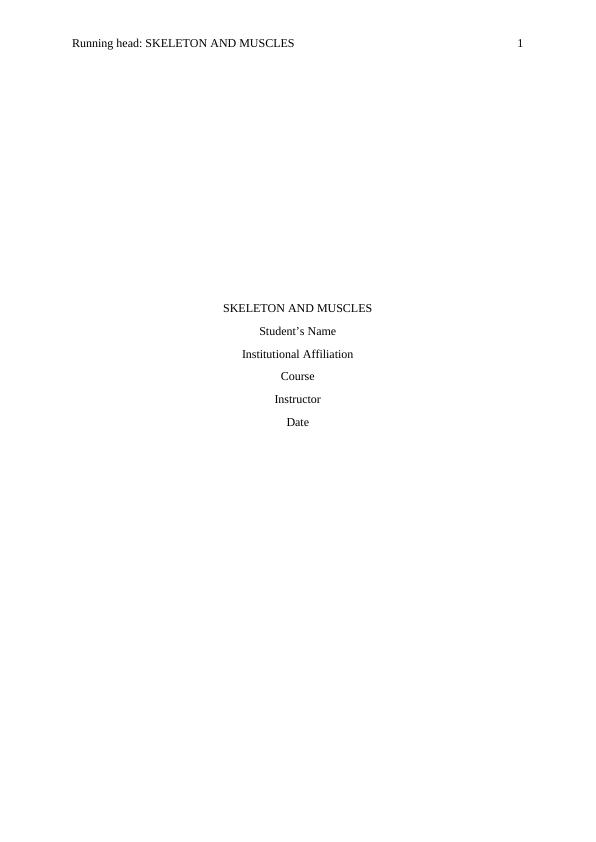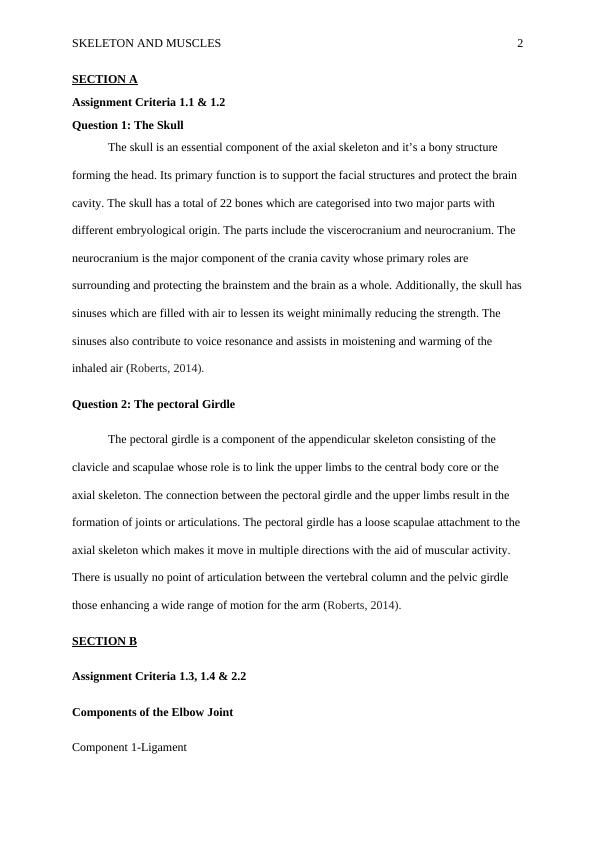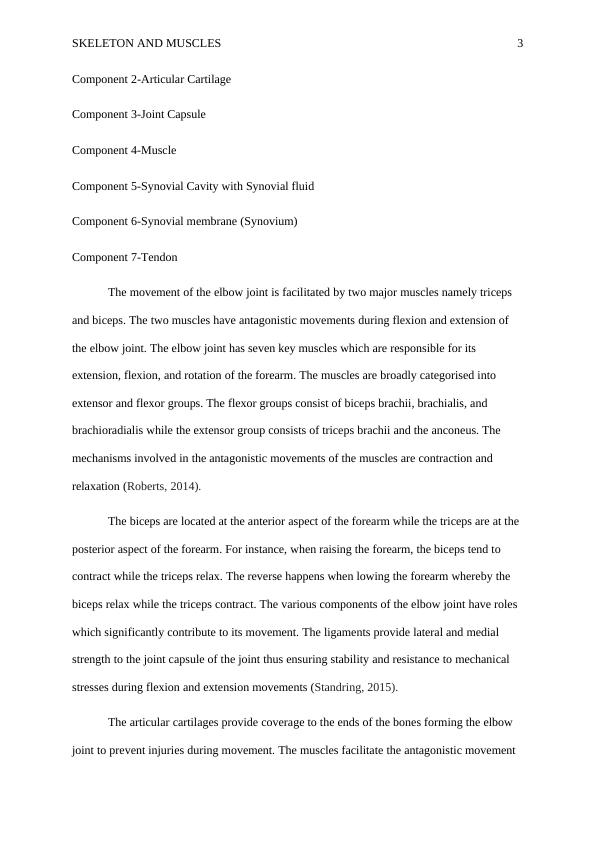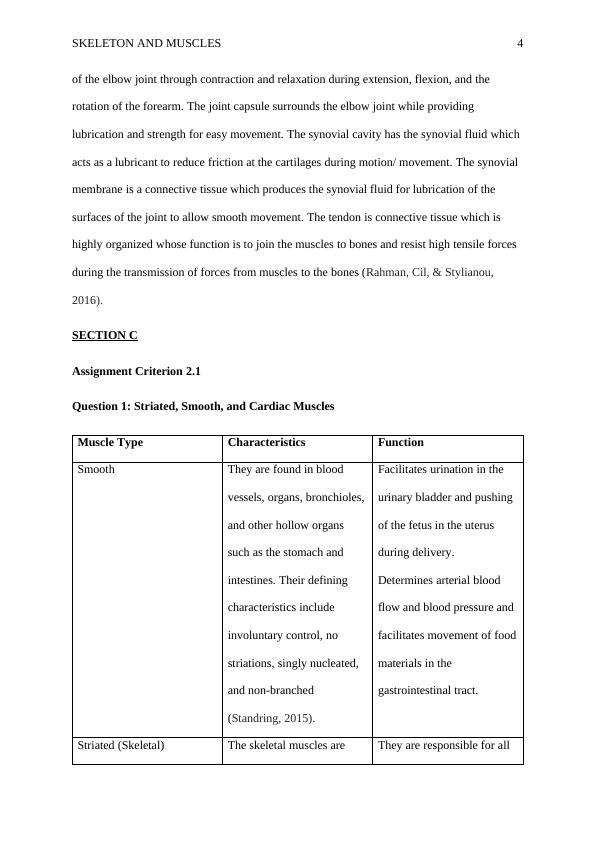Skeleton and Muscles: Components, Functions, and Effects on the Body | Desklib
11 Pages2922 Words154 Views
Added on 2022-11-16
About This Document
This document covers topics such as the skull, pectoral girdle, elbow joint components, muscle types, and the effects of osteoporosis. Suitable for students studying anatomy, physiology, and related courses.
Skeleton and Muscles: Components, Functions, and Effects on the Body | Desklib
Added on 2022-11-16
ShareRelated Documents
Running head: SKELETON AND MUSCLES 1
SKELETON AND MUSCLES
Student’s Name
Institutional Affiliation
Course
Instructor
Date
SKELETON AND MUSCLES
Student’s Name
Institutional Affiliation
Course
Instructor
Date

SKELETON AND MUSCLES 2
SECTION A
Assignment Criteria 1.1 & 1.2
Question 1: The Skull
The skull is an essential component of the axial skeleton and it’s a bony structure
forming the head. Its primary function is to support the facial structures and protect the brain
cavity. The skull has a total of 22 bones which are categorised into two major parts with
different embryological origin. The parts include the viscerocranium and neurocranium. The
neurocranium is the major component of the crania cavity whose primary roles are
surrounding and protecting the brainstem and the brain as a whole. Additionally, the skull has
sinuses which are filled with air to lessen its weight minimally reducing the strength. The
sinuses also contribute to voice resonance and assists in moistening and warming of the
inhaled air (Roberts, 2014).
Question 2: The pectoral Girdle
The pectoral girdle is a component of the appendicular skeleton consisting of the
clavicle and scapulae whose role is to link the upper limbs to the central body core or the
axial skeleton. The connection between the pectoral girdle and the upper limbs result in the
formation of joints or articulations. The pectoral girdle has a loose scapulae attachment to the
axial skeleton which makes it move in multiple directions with the aid of muscular activity.
There is usually no point of articulation between the vertebral column and the pelvic girdle
those enhancing a wide range of motion for the arm (Roberts, 2014).
SECTION B
Assignment Criteria 1.3, 1.4 & 2.2
Components of the Elbow Joint
Component 1-Ligament
SECTION A
Assignment Criteria 1.1 & 1.2
Question 1: The Skull
The skull is an essential component of the axial skeleton and it’s a bony structure
forming the head. Its primary function is to support the facial structures and protect the brain
cavity. The skull has a total of 22 bones which are categorised into two major parts with
different embryological origin. The parts include the viscerocranium and neurocranium. The
neurocranium is the major component of the crania cavity whose primary roles are
surrounding and protecting the brainstem and the brain as a whole. Additionally, the skull has
sinuses which are filled with air to lessen its weight minimally reducing the strength. The
sinuses also contribute to voice resonance and assists in moistening and warming of the
inhaled air (Roberts, 2014).
Question 2: The pectoral Girdle
The pectoral girdle is a component of the appendicular skeleton consisting of the
clavicle and scapulae whose role is to link the upper limbs to the central body core or the
axial skeleton. The connection between the pectoral girdle and the upper limbs result in the
formation of joints or articulations. The pectoral girdle has a loose scapulae attachment to the
axial skeleton which makes it move in multiple directions with the aid of muscular activity.
There is usually no point of articulation between the vertebral column and the pelvic girdle
those enhancing a wide range of motion for the arm (Roberts, 2014).
SECTION B
Assignment Criteria 1.3, 1.4 & 2.2
Components of the Elbow Joint
Component 1-Ligament

SKELETON AND MUSCLES 3
Component 2-Articular Cartilage
Component 3-Joint Capsule
Component 4-Muscle
Component 5-Synovial Cavity with Synovial fluid
Component 6-Synovial membrane (Synovium)
Component 7-Tendon
The movement of the elbow joint is facilitated by two major muscles namely triceps
and biceps. The two muscles have antagonistic movements during flexion and extension of
the elbow joint. The elbow joint has seven key muscles which are responsible for its
extension, flexion, and rotation of the forearm. The muscles are broadly categorised into
extensor and flexor groups. The flexor groups consist of biceps brachii, brachialis, and
brachioradialis while the extensor group consists of triceps brachii and the anconeus. The
mechanisms involved in the antagonistic movements of the muscles are contraction and
relaxation (Roberts, 2014).
The biceps are located at the anterior aspect of the forearm while the triceps are at the
posterior aspect of the forearm. For instance, when raising the forearm, the biceps tend to
contract while the triceps relax. The reverse happens when lowing the forearm whereby the
biceps relax while the triceps contract. The various components of the elbow joint have roles
which significantly contribute to its movement. The ligaments provide lateral and medial
strength to the joint capsule of the joint thus ensuring stability and resistance to mechanical
stresses during flexion and extension movements (Standring, 2015).
The articular cartilages provide coverage to the ends of the bones forming the elbow
joint to prevent injuries during movement. The muscles facilitate the antagonistic movement
Component 2-Articular Cartilage
Component 3-Joint Capsule
Component 4-Muscle
Component 5-Synovial Cavity with Synovial fluid
Component 6-Synovial membrane (Synovium)
Component 7-Tendon
The movement of the elbow joint is facilitated by two major muscles namely triceps
and biceps. The two muscles have antagonistic movements during flexion and extension of
the elbow joint. The elbow joint has seven key muscles which are responsible for its
extension, flexion, and rotation of the forearm. The muscles are broadly categorised into
extensor and flexor groups. The flexor groups consist of biceps brachii, brachialis, and
brachioradialis while the extensor group consists of triceps brachii and the anconeus. The
mechanisms involved in the antagonistic movements of the muscles are contraction and
relaxation (Roberts, 2014).
The biceps are located at the anterior aspect of the forearm while the triceps are at the
posterior aspect of the forearm. For instance, when raising the forearm, the biceps tend to
contract while the triceps relax. The reverse happens when lowing the forearm whereby the
biceps relax while the triceps contract. The various components of the elbow joint have roles
which significantly contribute to its movement. The ligaments provide lateral and medial
strength to the joint capsule of the joint thus ensuring stability and resistance to mechanical
stresses during flexion and extension movements (Standring, 2015).
The articular cartilages provide coverage to the ends of the bones forming the elbow
joint to prevent injuries during movement. The muscles facilitate the antagonistic movement

SKELETON AND MUSCLES 4
of the elbow joint through contraction and relaxation during extension, flexion, and the
rotation of the forearm. The joint capsule surrounds the elbow joint while providing
lubrication and strength for easy movement. The synovial cavity has the synovial fluid which
acts as a lubricant to reduce friction at the cartilages during motion/ movement. The synovial
membrane is a connective tissue which produces the synovial fluid for lubrication of the
surfaces of the joint to allow smooth movement. The tendon is connective tissue which is
highly organized whose function is to join the muscles to bones and resist high tensile forces
during the transmission of forces from muscles to the bones (Rahman, Cil, & Stylianou,
2016).
SECTION C
Assignment Criterion 2.1
Question 1: Striated, Smooth, and Cardiac Muscles
Muscle Type Characteristics Function
Smooth They are found in blood
vessels, organs, bronchioles,
and other hollow organs
such as the stomach and
intestines. Their defining
characteristics include
involuntary control, no
striations, singly nucleated,
and non-branched
(Standring, 2015).
Facilitates urination in the
urinary bladder and pushing
of the fetus in the uterus
during delivery.
Determines arterial blood
flow and blood pressure and
facilitates movement of food
materials in the
gastrointestinal tract.
Striated (Skeletal) The skeletal muscles are They are responsible for all
of the elbow joint through contraction and relaxation during extension, flexion, and the
rotation of the forearm. The joint capsule surrounds the elbow joint while providing
lubrication and strength for easy movement. The synovial cavity has the synovial fluid which
acts as a lubricant to reduce friction at the cartilages during motion/ movement. The synovial
membrane is a connective tissue which produces the synovial fluid for lubrication of the
surfaces of the joint to allow smooth movement. The tendon is connective tissue which is
highly organized whose function is to join the muscles to bones and resist high tensile forces
during the transmission of forces from muscles to the bones (Rahman, Cil, & Stylianou,
2016).
SECTION C
Assignment Criterion 2.1
Question 1: Striated, Smooth, and Cardiac Muscles
Muscle Type Characteristics Function
Smooth They are found in blood
vessels, organs, bronchioles,
and other hollow organs
such as the stomach and
intestines. Their defining
characteristics include
involuntary control, no
striations, singly nucleated,
and non-branched
(Standring, 2015).
Facilitates urination in the
urinary bladder and pushing
of the fetus in the uterus
during delivery.
Determines arterial blood
flow and blood pressure and
facilitates movement of food
materials in the
gastrointestinal tract.
Striated (Skeletal) The skeletal muscles are They are responsible for all

End of preview
Want to access all the pages? Upload your documents or become a member.
Related Documents
(PDF) Occupational Therapylg...
|8
|1008
|32
Biology Assignmentlg...
|4
|598
|115
Skeletal and Muscular System PDFlg...
|9
|2257
|350
